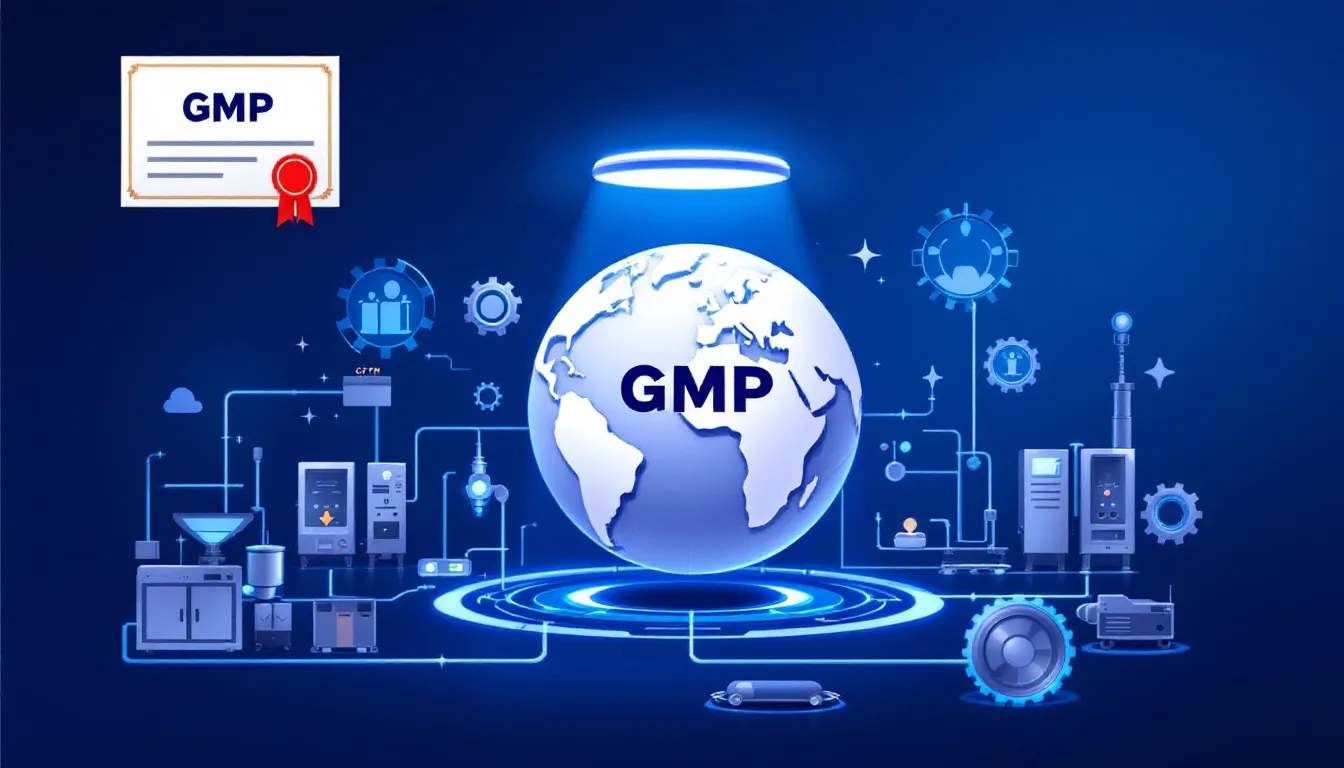Pharmaceutical third party manufacturing is when companies outsource product production to specialized firms. This practice enables companies to focus on research and development. In this guide, we’ll cover the benefits, processes, and considerations of third party manufacturing.
Pharmaceutical third party manufacturing enables companies to outsource production, allowing them to focus on research and development while achieving cost savings and ensuring product quality.
The process involves selecting reliable manufacturers, developing formulations, and maintaining strict quality control to uphold regulatory compliance in a competitive industry.
Emerging trends such as biologics and technologically advanced production methods are reshaping third party manufacturing, emphasizing the importance of sustainability and innovation for future growth.

Pharmaceutical third party manufacturing is a service where a company hires another to produce its pharmaceutical products. This practice, commonly known as contract manufacturing, allows pharmaceutical companies to bring their products to market without the need to invest in their own manufacturing facilities. Collaboration with third party manufacturers allows companies to concentrate on their core competencies like research and development, utilizing the advanced facilities and expertise of specialized manufacturers to ensure high-quality production.
Third party manufacturing plays a crucial role in the competitive pharmaceutical industry. It provides a strategic advantage by allowing companies to manage costs effectively according to their production needs, thus enhancing productivity and efficiency. Furthermore, the hiring firm specifies quality standards, ensuring adherence to required regulations and consistent product quality.
This guide aims to provide a comprehensive overview to help you navigate the risks and rewards involved in pharmaceutical contract manufacturing.

Third party manufacturing offers a multitude of benefits for pharmaceutical companies, making it an attractive option in the dynamic pharmaceutical industry. Key benefits include significant cost savings, access to advanced technology and expertise, and unparalleled scalability and flexibility.
Outsourcing production allows pharmaceutical companies to cut operational expenses, access cutting-edge technologies, and adjust production volumes in response to market demand.
Here is a table listing five prominent pharmaceutical third party manufacturing companies, known for their expertise and advanced manufacturing capabilities:
| Company Name | Headquarters | Key Services Offered | Notable Clients |
|---|---|---|---|
| Lonza Group | Basel, Switzerland | Biologics and small molecule manufacturing | Moderna, Roche |
| Catalent, Inc. | Somerset, USA | Drug development, delivery technologies | Johnson & Johnson, Pfizer |
| Recipharm AB | Stockholm, Sweden | Contract development and manufacturing | AstraZeneca, Pfizer |
| Siegfried Holding AG | Zofingen, Switzerland | Active pharmaceutical ingredient production | Novartis, Sanofi |
| Aurobindo Pharma | Hyderabad, India | Generic drug manufacturing and development | Novartis, Pfizer |
These companies are renowned for their commitment to quality, regulatory compliance, and innovative solutions in pharmaceutical contract manufacturing. By partnering with these reliable third party manufacturers, pharmaceutical companies can efficiently bring high-quality products to market.
Outsourcing manufacturing can save pharmaceutical companies a lot of money. By not having to spend on building and running their own manufacturing facilities, companies can use their funds for other important areas like marketing, research, and business growth. A real-life example is the partnership between Novartis and Aurobindo Pharma, which helped them cut down production costs significantly and run their operations more efficiently.
Additionally, pharmaceutical contract manufacturers often work with multiple clients, which helps them spread out their costs and offer lower prices. This allows companies to focus on their main activities without worrying about the high costs of maintaining their own production facilities.
Overall, the savings from third-party manufacturing can be used to invest in other critical areas, encouraging growth and new ideas in the pharmaceutical business.
Other companies that make things for drug makers spend a lot of money on good tools to make work faster and products better. New stuff like smart computers, robots, and tracking systems are changing how medicines are made, making less waste, better quality, and letting everyone see what’s happening. These better tools help drug companies make good products that follow all the rules.
For instance, Pfizer has successfully integrated artificial intelligence to optimize its manufacturing processes, resulting in improved efficiency and product quality. Similarly, Novartis has embraced blockchain technology to enhance transparency across its supply chain, ensuring compliance with industry regulations and improving overall operational transparency.
Using the special skills and good buildings of these other makers helps drug companies make products faster and get them to stores quicker. Working together this way lets companies focus on finding new medicines while still using the newest and best tools.
Using other companies to make your products has big plus points. One of the best things is that they can make more or less stuff when you need it. Drug companies can change how much they make based on what people want, so they can keep customers happy without wasting money. This is really important in medicine making, where what people need can change fast.
A prime example is the collaboration between Moderna and CordenPharma for mRNA vaccine production. This partnership allowed Moderna to significantly ramp up production to meet the global demand during the COVID-19 pandemic, showcasing the scalability and flexibility of third-party manufacturing.
Also, having other companies make your products helps things run smoother and lets you grow easier, so you can handle the ups and downs of what people want. Being able to change like this not only helps new ideas grow but also makes sure companies can keep up in the always-changing medicine world.

The process of third party manufacturing in pharmaceuticals involves several critical steps, starting from product selection and formulation development to choosing a reliable manufacturer and conducting rigorous quality control. This comprehensive approach ensures that pharmaceutical products meet the required specifications and performance criteria before reaching the market.
Understanding this process is essential for pharmaceutical companies looking to leverage third party manufacturing to enhance their production capabilities.
Selecting a reliable third party manufacturer is a crucial step in the contract manufacturing process. Pharmaceutical companies should prioritize manufacturers with strong industry reputations, proven reliability, and necessary certifications to ensure compliance with industry standards.
Industry Reputation and Reliability: Evaluate the manufacturer’s reputation and reliability within the industry to ensure they can provide high-quality production services.
Certifications and Compliance: Ensure the manufacturer has the necessary certifications and complies with industry and regulatory body (e.g., FDA) requirements.
Track Record: Review the manufacturer’s history with regulatory bodies to ensure they meet all regulatory requirements and maintain consistent product quality.
Geographical Location and Logistics: The manufacturer’s location can significantly impact communication and cost-effectiveness. Choosing a nearby manufacturer can enhance communication
The formulation development phase is a pivotal step in third party manufacturing, involving the creation of a product formulation that meets specific performance criteria and regulatory standards. This phase is crucial as it directly impacts the efficacy and safety of the final pharmaceutical product. Collaborations, such as the one between Upsher-Smith and Bosch Pharma, underscore the importance of leveraging specialized knowledge and advanced facilities to enhance the formulation development process.
Key Aspects of Formulation Development:
Regulatory Standards Compliance: Ensures all formulations meet the stringent guidelines set by regulatory agencies, such as the FDA and EMA, to guarantee product safety and efficacy.
Advanced Facilities: Utilizes cutting-edge technology and state-of-the-art facilities to optimize formulation processes, reducing time-to-market by up to 30%.
Quality control and assurance are paramount in third party manufacturing. Comprehensive testing methods are implemented to ensure product safety, efficacy, and compliance with regulatory standards. Dedicated quality assurance teams play a critical role in maintaining high-quality production through stringent quality control measures.
Emerging technologies, such as artificial intelligence, are being adopted to streamline compliance processes and enhance manufacturing efficiency. These technologies help ensure that products meet regulatory and quality standards, reducing the risk of regulatory fines and recalls.
Maintaining high-quality standards during production is essential to ensure consistent product quality, rigorous quality control processes, and regulatory compliance.

Regulatory compliance is a critical aspect of third party manufacturing in the pharmaceutical industry. The sector is governed by strict regulations that ensure drugs are safe, effective, and manufactured to high standards. Contract manufacturers must comply with Good Manufacturing Practices (GMP) and other applicable regulations to ensure product quality and safety.
By outsourcing production to third party manufacturers, pharmaceutical companies can reduce the regulatory burden and minimize the risk of non-compliance. Third party manufacturers ensure compliance with regulatory standards during production processes, providing consistent product quality and reducing costs associated with regulatory compliance.
This compliance is crucial for maintaining public trust and safety in the pharmaceutical industry.

Third party manufacturing has many benefits. However, it also comes with specific challenges and risks. Quality control issues can arise due to variations in product quality across batches, resulting from differing standards and practices of third party manufacturers. Regulatory compliance is essential for public trust and safety, and navigating complex regulatory environments can be challenging for pharmaceutical companies.
Other risks include production delays, supply chain disruptions, and financial instability, which can hinder the timely delivery of products. Establishing strong communication channels and conducting regular audits can help mitigate these risks and enhance overall operational efficiency. Addressing these challenges is crucial for maintaining consistent product quality and ensuring the success of third party manufacturing partnerships.
The pharmaceutical contract manufacturing sector is undergoing significant transformation, driven by emerging trends and future prospects. Biologics, personalized medicines, and advanced technologies are gaining prominence as the market adapts to the need for tailored healthcare solutions.
These trends are shaping the future of third party manufacturing, offering new opportunities for pharmaceutical companies to innovate and grow.
The demand for biologics and personalized medicines is on the rise, driven by advancements in genomic science and their efficacy in treating complex diseases. This trend has a substantial influence on third party manufacturing processes, as companies seek to produce tailored treatments for individual patient profiles.
A notable example is Moderna’s collaboration with CordenPharma, which has significantly increased the production capacity of mRNA vaccines to meet global demand. This partnership highlights the importance of third party manufacturing in rapidly responding to emerging health crises and enhancing public health.
Technological advancements are revolutionizing the pharmaceutical manufacturing landscape. The use of 3D printing, for instance, allows for the creation of personalized medications tailored to individual patient needs, enhancing treatment outcomes and patient satisfaction. Automation has also accelerated production efficiency, particularly during workforce reductions prompted by the pandemic, ensuring that production lines remain operational and efficient.
Artificial intelligence is another game-changer, optimizing manufacturing processes, analyzing patient data, and predicting medicine effectiveness for better production outcomes. The adoption of continuous manufacturing techniques further enhances efficiency and reduces waste, making the production process more sustainable and cost-effective.
These technological advancements enable pharmaceutical companies to innovate and maintain a competitive edge in the market.
Sustainability and Environmental, Social, and Governance (ESG) compliance are becoming increasingly important in the pharmaceutical industry. Companies are integrating sustainable practices into their operations to meet stakeholder demands for greater accountability and regulatory pressures. This shift towards sustainability is reshaping strategies within the pharmaceutical contract manufacturing sector, focusing on reducing environmental impact and enhancing social responsibility.
Pharmaceutical companies are adopting eco-friendly practices in their manufacturing processes, such as reducing energy use and utilizing renewable resources. By prioritizing ESG compliance, companies not only contribute to a healthier planet but also build trust and credibility with consumers and regulators alike.
Analyzing successful third party manufacturing partnerships provides valuable insights into what makes these collaborations thrive. Open communication, detailed contracts, long-term vision, technology integration, continuous process improvements, and a focus on innovation are key factors that contribute to the success of these partnerships.
The following case studies highlight notable examples of successful collaborations in the pharmaceutical industry.
Pfizer and Johnson & Johnson have embarked on a blockchain initiative to enhance supply chain transparency. This project focuses on using blockchain technology to trace raw materials used in pharmaceutical products, ensuring compliance with industry regulations and enhancing overall transparency. By mandating blockchain for raw material tracing, both companies aim to comply with the U.S. DSCSA Act and build a more reliable supply chain.
The blockchain initiative not only improves regulatory compliance but also fosters trust among stakeholders by providing a transparent view of the supply chain. This innovative approach highlights the potential of blockchain technology to revolutionize supply chain management in the pharmaceutical industry, ensuring that products are safe, effective, and of the highest quality.
Moderna and CordenPharma have grown their teamwork to make many more mRNA vaccine doses. This bigger teamwork happens because so many people around the world need mRNA vaccines during health crises, showing why outside makers are so important for public health. They want to make 100 million extra doses in 2024, which shows how outside makers can quickly step up to help when needed.
What we hope to get from this teamwork is more vaccines for everyone and better readiness for future health emergencies. By using CordenPharma’s special making skills, Moderna can make sure they get good mRNA vaccines made on time, helping keep people healthy worldwide.
Novartis and Aurobindo Pharma started working together to use what each does best in making drugs. This teamwork has saved both companies lots of money by making work better and using resources smarter. Novartis gave 80% of its small-molecule drug making to Aurobindo Pharma and saved $500 million each year, showing how outside makers can save you money.
Through this teamwork, both companies got better by making work smoother and boosting how they make things. The teamwork created a win-win that helped both companies make money and work better, showing other drug makers why they might want to try outside manufacturing too.
Starting with outside manufacturing means doing good research to find the right makers. Drug companies should check if makers are trustworthy, can make enough drugs, and follow all the rules. Writing clear agreements is very important to spell out costs, timelines, and quality needs.
Good talking and working closely together helps stop mix-ups and makes sure drug companies and makers agree on what to do. During the whole making process, checking quality is super important to keep things good and make sure the drugs turn out right.
Following these steps helps companies use outside makers well, which lets them make more drugs.
In short, using outside drug makers has many good points, like saving money, getting better tools and know-how, and making more when needed. It lets drug companies focus on what they do best while using the special skills and buildings of outside makers. But there are also hard parts like making sure the drugs are good and following all the rules, which need careful handling.
Looking ahead, the future of outside drug making looks bright, with new trends like biologics, personal medicines, and new tech driving better ways to work. By understanding the process, good points, hard parts, and future trends, drug companies can make smart choices and do well with outside manufacturing. Using this approach can lead to big growth, better work, and new ideas in the drug industry.
Pharmaceutical third party manufacturing, or contract manufacturing, enables companies to outsource the production of their pharmaceutical products, thereby reducing the need for investment in manufacturing facilities. This approach facilitates quicker market entry and operational efficiency.
The key benefits of third-party manufacturing for pharmaceutical companies include substantial cost savings, access to advanced technologies and expertise, and enhanced scalability and flexibility. These advantages enable companies to optimize operational efficiency and respond effectively to market demands.
Third-party manufacturers ensure regulatory compliance by adhering to Good Manufacturing Practices (GMP) and implementing robust quality control processes. This includes close collaboration with regulatory bodies to maintain the necessary standards for product quality and safety.
The challenges associated with third-party manufacturing are significant, including quality control issues, regulatory compliance complexities, production delays, and supply chain disruptions, all of which can adversely affect timely product delivery and necessitate diligent management.
A pharmaceutical company can begin third party manufacturing by thoroughly researching potential manufacturers, assessing their reliability and production capabilities, and establishing detailed contracts. Maintaining effective communication and implementing quality assurance measures are vital for successful partnerships.




Manufacturing pharmaceutical products should always be taken seriously. That is, every process must follow the strictest and highest standards. This is the very reason why manufacturers prefer hiring an EPC contractor. Contractors working under EPC contracts will ensure the outcomes are of the best quality no matter what happens, focusing on the construction of the […]

Explore the importance of EPC contracts in pharmaceutical manufacturing. Learn how EPC works, its benefits, and why choosing an EPC contractor can guarantee project success with Canaan’s industry-leading equipment.

Discover how SCADA and PLC improve automation in the pharmaceutical industry. Learn their roles, benefits, and how Canaan’s advanced technology enhances efficiency and safety.